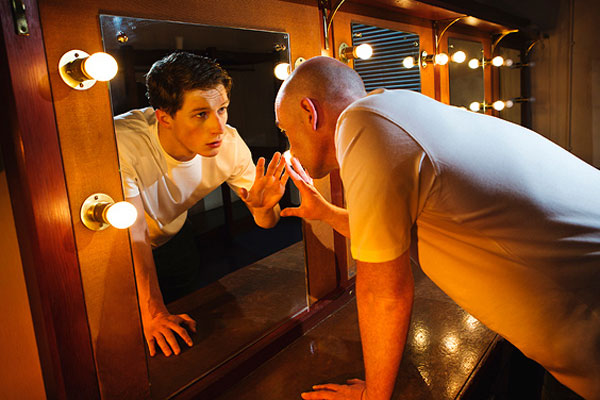Showing @ Summerhall, Edinburgh until Sat 26 Oct @ 19:30
This review contains spoilers.
Like with The Salon Project, Untitled Projects’ newest piece directed by Stewart Laing, experiments with how audience perspective can be altered to change the manner in which theatre is understood and appreciated.
Presented as a lecture, actor George Anton talks about a series of theatrical productions directed by Paul Bright in the late 1980s, adapting 18th century Scottish novelist James Hogg’s seminal work The Private Memoirs and Confessions of a Justified Sinner. Using archive footage, interviews, still images and his own first hand account, Anton paints a picture of the eccentric Bright and his unconventional approach to drama, as well as his own personal experiences of working with him.
Before the show begins, the audience is shepherded through an exhibition of Paul Bright memorabilia; old flyers, videos of his work and newspaper clippings all working to familiarise the auteur’s mindset. There’s little set other than a large projector screen and a light-box-come-desk, which occasionally Anton leans over, menacingly under-lighting himself, resonating with the many dark and unusual aspects of Bright’s productions.
Although there are a few occasions when the technology is out of sync with Anton’s delivery, the multimedia aspects break up the set’s otherwise fairly static nature and allow for a fuller immersion into Bright’s intriguing character. Anton’s nostalgic and enlightening musings are generally vividly expressed but periodically, and this is also the wording, it feels like an actor reciting lines rather than a friend reminiscing.
However, predominantly the script is evocatively detailed, as Bright is explained to you through a series of descriptions of himself and his work, painting an intimate picture of this strong-headed and fiery individual. The relationship between Anton and Bright, a few close years and then distant separation, accentuates Bright’s loner, outcast image, not understood by the artistic masses. The exhibited prelude, technological features and strength of character description in the text forge a connection between audience and the troubled Bright, personalising this relationship more than in a conventional setting.
The question of ‘what is art?’ specifically theatre is broached at many moments during Anton’s monologue. Bright’s style of drama constantly pushes the boundary between theatre and reality, trying to find the extremes of naturalism whilst still being performance. This is what makes Laing’s production so interesting. By presenting the fictional Bright’s fictional staging as real events, Laing flips the concept of blurring reality and theatre onto the very talk being given. A meta-theatricality is created, as the talk about a play becomes a play that questions the very nature of theatre, using the invented retrospective to showcase the traditional and technological ways its definition can be challenged. It is a welcome and fascinating concept to be left thinking about.
Follow Callum on Twitter @CWMadge
